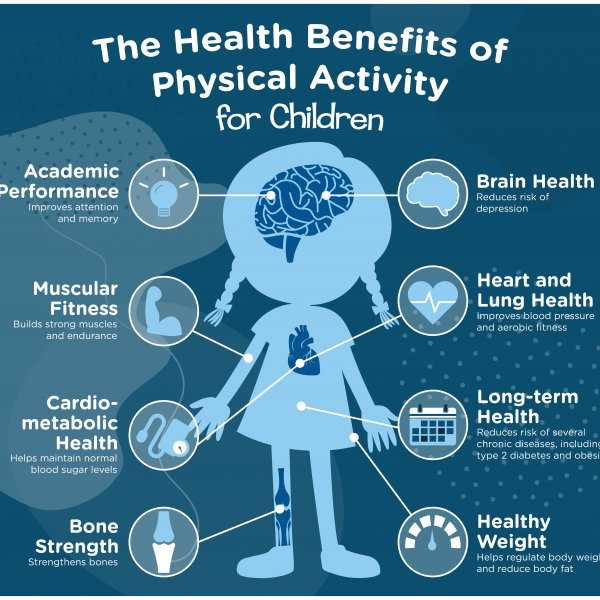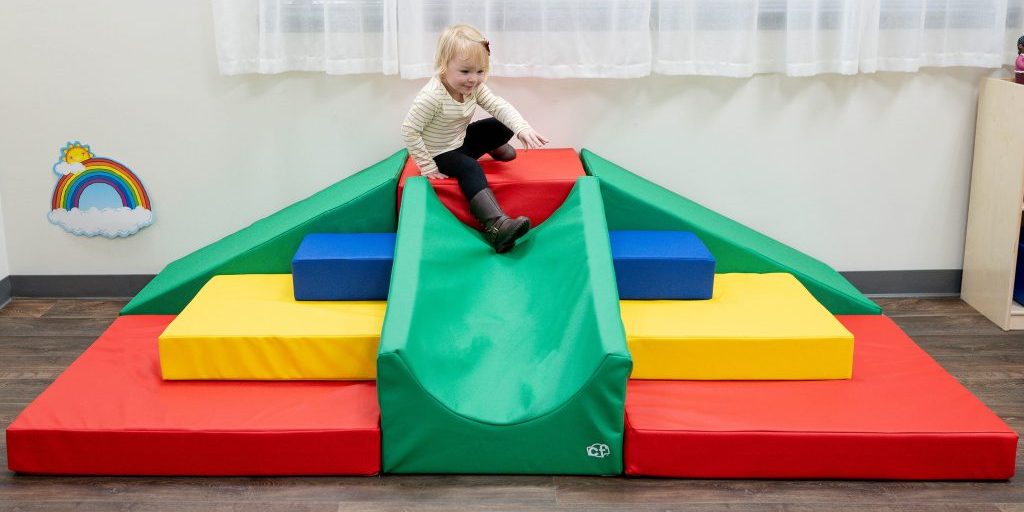
How Many Physical Activities Do Preschool-Aged Kids Require?
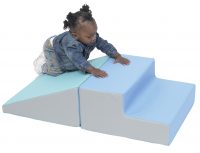
Available in 3 color options, the Up & Down 2-Piece Play Set is perfect for small spaces.
Research conducted from 1986-2007 measuring the level of physical activity of over 10,000 preschool-aged kids (ranging in age from 2-6 years old) from 7 different countries concluded, nearly half of all children do not engage in sufficient physical activity¹. Standards set up by the National Association for Sport and Physical Education (NASPE) were used as guidelines. NASPE recommends preschool-aged children engage in a minimum of 60 minutes of physical activity each day.
The CDC recommends children 3-5 years old stay active throughout the day. In comparison, children 6-15 years of age require 60 minutes of daily physical activity. Experts seem to agree on a few key points. Kids require a minimum amount of physical activities. Unfortunately, a large portion of children fail to participate in the minimum standards for daily physical activities.
Why Are Physical Activities for Kids So Important?
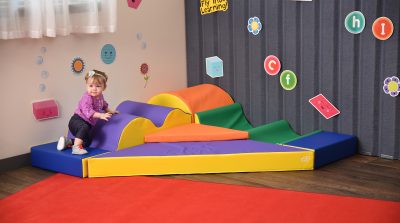
Soft play equipment promotes the development of healthy muscles and bones. (Pictured here: Marshmallow Upside Downs)
Kids Directly Benefit
Benefits include:
- Heart and lung health
- Improved long-term health. Physical activity reduces the risk of developing chronic diseases, such as type 2 diabetes and obesity
- Helps keep weight at healthy levels and reduces body fat
- Strengthens bones and builds strong muscles
- Regulates blood sugar levels
- Less apt to be depressed
- Gross motor skills such as balance and coordination are enhanced
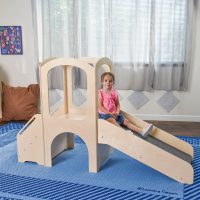
Our Toddler Loft Set allows kids to set the pace with their physical activities.
Teachers Benefit
Teachers appreciate the following5:
- Kids are likely to be happier! Physical activity stimulates the production of neurotransmitters called dopamine, norepinephrine, and serotonin in the brain, which are responsible for our sense of well-being.
- Physical activity leads to the brain functioning better, which improves memory and attention span. Participating in regular physical activities prepares children to learn. Therefore, many do better in school.
- Proper levels of daily physical activity improves student behavior in the classroom. Additionally, students stay on task more frequently.
Aerobic, Muscle-Strengthening, & Bone-Strengthening Activities7
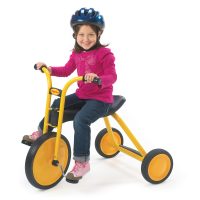
Providing kids with trikes, bikes, or scooters will encourage them to get some exercise! (Pictured here: AFB3630 – MyRider Maxi.)
Finding the right ratio of different physical activities can be difficult. Start by using a good mix of the main three types of physical activities. These activities develop gross motor skills.
Aerobic Physical Activities for Kids
These activities rate as moderate-intensity to high-intensity. They require kids to rhythmically move their large muscles for sustained periods of time. For example: running, jumping rope, skipping, hopping, swimming, dancing, tricycle and bicycle riding, and gymnastics. Basically, most games requiring kids to catch, throw, and/or kick qualify. Many moderate-intensity activities can also be classified as high-intensity depending on the child and the rigorousness with which the child engages in the activity.
Muscle-Strengthening Physical Activities for Kids
These are defined as activities where muscles perform more work than usual during daily activities. Many unstructured play activities can be classified as muscle-strengthening. For instance, playing on playground equipment such as a teeter-totter, climbing trees, playing tug-of-war, playing tag with pals, potato sack races, and romping on soft play equipment are all examples of muscle-strengthening activities.
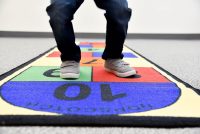
Hopscotch is a classic playground favorite. It also promotes strong bones and muscles. (LC121)
Bone-Strengthening Physical Activities for Kids
Bone-strengthening activities produce a force on the body’s bones. This force promotes bone growth and strength. For example, impact with the ground exerts forces on the bones that strengthens them. Playing hopscotch, basketball, dodgeball, kickball, and basically any activity that requires running and/or jumping develops bone strength.
For the most part, discovering the right ratio of activities can be difficult. Teachers and caregivers might start by dividing the 60 minutes a day recommended by the CDC and the NASPE into thirds: 20 minutes for moderate to high-intensity aerobic activities, 20 minutes for muscle-strengthening, and 20 minutes for bone-strengthening.
7 Ways to Encourage Children to be Physically Active
- Begin when kids are young! Encouraging kids to be active from a young age builds lifelong habits.
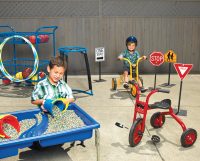
The ClassicRider 10” Pedal Pusher Trike was built to endure daily use and to last a lifetime.
- Set a good example. Encourage children to be more active by leading an active lifestyle yourself. The entire family benefits.
- Encourage after dinner physical activities for kids. Instead of watching television or gaming, parents might try encouraging kids to play with other kids in the neighborhood. Furthermore, walking or riding bikes as a family takes everything to the next level. (See benefit #2.) Remember the old school game Twister? Playing Twister with the kids builds strong muscles without needing to leave the house!
- Take kids to places where they can have fun and be active! Take kids to the park, ice-skating rink, a trampoline park, or to monkey around at an adventure park with zip-lines and rope courses. Use your imagination. Conceive of activities to help kids get some exercise benefits their long-term health.
- Providing kids with the equipment they need to get some exercise is an investment. Maybe you buy them a tricycle for their birthday? Potentially, buying a few gym mats could present the perfect opportunity for you to show your tikes some stretching exercises or yoga poses. Opportunities are endless.
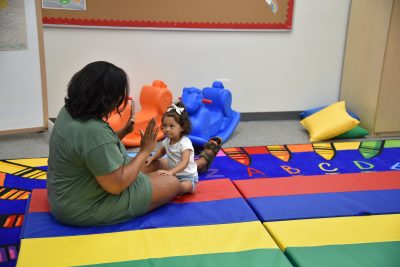
Rainbow Folding Gym Mats make it easy to achieve 60 minutes of physical activity each day.
- Be positive about the physical activities in which your children currently participate. Encourage them to try new activities.
- Make physical activities fun. This might just be a part of #’s 1-6. It’s an important reminder, participating with your kids makes each activity as fun as possible. Your work making activities fun will inspire children to love your time spent together exercising.
What’s your favorite physical activity for toddlers and preschool-aged children?
References:
- http://funnelcakes.pbworks.com/f/5983903470907061970.pdf
- https://www.cdc.gov/physicalactivity/basics/children/index.html
- https://www.cdc.gov/physicalactivity/basics/adding-pa/activities-children.html
- https://www.cdc.gov/physicalactivity/basics/adults/health-benefits-of-physical-activity-for-children.html
- https://www.cdc.gov/healthyschools/physicalactivity/school_pa_benefits.htm
- https://www.cdc.gov/physicalactivity/basics/adding-pa/activities-children.html
- https://health.gov/sites/default/files/2019-09/Physical_Activity_Guidelines_2nd_edition.pdf
